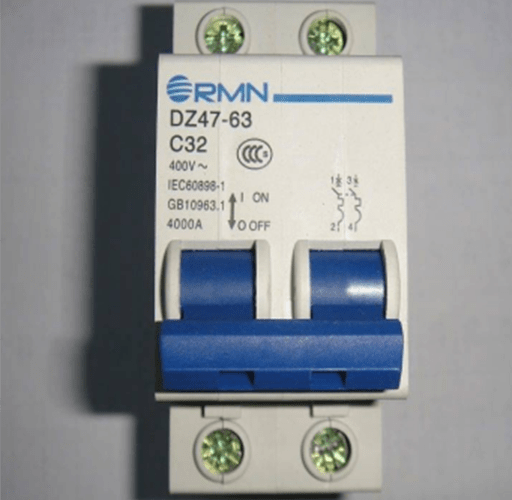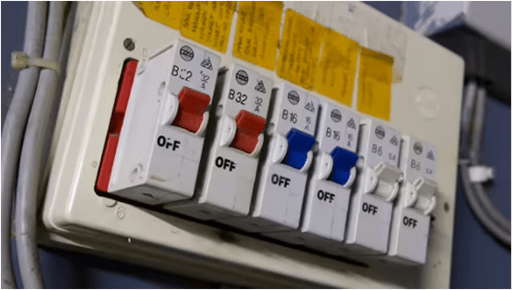
Figure 1: Circuit breaker.
One of the most common problems within a home electrical system is circuit breaker tripping. Circuit breakers used in most homes shut off power to a room in the event of an electrical overload or short circuit. Circuit breakers conveniently cut power only to the circuit with problems, without shutting down any equipment in the house. In this case, how do we turn the circuit breaker back on? In fact, resetting a circuit breaker is an easy process as long as you follow some basic safety guidelines.
1. Three Steps to Reset a Circuit Breaker
1.1 Step 1: Unplug the Appliance
Start by checking all appliances or outlets in your home that are powered off, turning off all lights and unplugging any appliances that are plugged into outlets in the affected room. When unplugging an appliance, check for any wires that look damaged or are hot to the touch. If you're sure your device is damaged or overheated, recycle it and buy a new one.
Warn
If you smell burning wires, hear a loud bang, or your home is struck by lightning, please call an electrician right away. Do not attempt to reset the circuit breaker yourself.

Figure 2: Burnt circuit breaker.
1.2 Step 2: Check Your Surroundings
Make sure the breaker box, surrounding area, and floor below are completely dry. Take a flashlight and open the breaker panel so you can see the breaker inside. Each circuit breaker has three positions: ON, OFF, and middle. Look for a circuit breaker with a switch in the middle position.
1.3 Step 3: Reset the Tripped Circuit Breaker
Flip the switch to the OFF position, and then flip it to the ON position. Wait a moment to see if the circuit breaker remains in the ON position. If so, reset the circuit breaker and restore power. Turn on a light to see if it is working properly. If the switch does not remain in the ON position, there is a serious wiring problem. Please contact a qualified electrician.
Assuming that after resetting the circuit breaker, the power remains on, and the lights or other appliances are working properly, it's time to figure out the cause of the problem. The two most common causes are short circuits in equipment or too many equipment running at the same time and overloading the circuit.
If a high-powered device is used or the circuit is loaded so much that the circuit breaker trips, either turn off some power-consuming devices, such as air conditioners or heaters, or plug them into an outlet on a different circuit.
2. What to Do If Circuit Breaker Won't Reset

Figure 3: Circuit breaker
After the circuit breaker has tripped, you may have tried to reset it as above. But occasionally, the circuit breaker won't reset or keep tripping. So what should you do if your circuit breaker won't reset?
2.1 Make Sure the Right Reset Way Used
First, make sure you're taking the correct steps to reset the circuit breaker. Also, be sure to push the circuit breaker handle firmly and fully to the OFF position and then back to the ON position.
2.2 Check for Signs of Circuit Overload
Signs of an overloaded circuit may look like this: a circuit breaker trips, doesn't reset immediately, resets after a cool-down period, and then trips again a few minutes later. The cause of an overloaded circuit is usually too many heavy loads plugged into an outlet on the same circuit, or a faulty device plugged into the circuit that is causing the problem. Circuit overloading is common in older kitchens and bathrooms, where there are often multiple appliances plugged into the same circuit.
Troubleshooting ways: unplug all plugs and reset the circuit breaker. If it keeps in the ON position, plug in the previously connected devices or appliances one by one until you find the problem.

Figure 4: Testing the circuit breaker.
2.4 Check for a Short Circuit
If the circuit breaker doesn't reset and trip right away, the problem may be a short circuit. A short circuit occurs when the current-carrying hot wire touches the neutral wire. In this case, flipping the circuit breaker is a safety mechanism, which proves that the circuit breaker is working properly. Short circuits can cause electrical damage, overheating, and even fire. If you suspect a short circuit is the reason that the breaker keeps tripping, please turn off the breaker and call a licensed electrician.
2.5 Check Whether the Circuit Breaker is Faulty
Although much less likely, the circuit breaker itself could be faulty. If this is the case, you definitely need to call a licensed electrician for help.
2.4 Call an Electrician for Help
Whether you're inexperienced, uninterested, or too busy to find the root cause of why your circuit breaker won't reset, seeking professional help is the surest and safest thing to do.
Related Info
How to Replace a Circuit Breaker?How Does a Refrigeration Compressor Work? With Animation for Each Type
Analysis and troubleshooting of common faults in cold and hot water air conditioning systems


